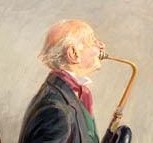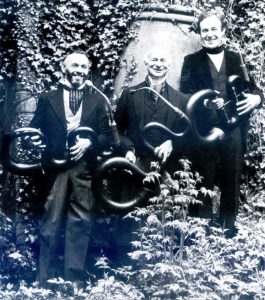
reprinted from The Independent, 20 July 1991
Christopher Monk was one of the best-loved figures in the world of early music and a notable eccentric in an admittedly crowded field. More than anyone else he has been responsible for the restoration to our soundworld of the Renaissance cornett, the beauty of which ancient writers compared to that of a choirboy’s voice; that one no longer hears works such as the 1610 Vespers with anything other than Monteverdi’s instrumentation is largely due to Monk’s influence as a player, maker, scholar and enthusiast.
He read history at Oxford and studied the trumpet with George Eskdale. His first cornett was completed in 1955 while he was a prep school teacher - he taught first at Pocklington in the East Riding, then at St Edmunds, Hindhead; Tom Stoppard and Jonathan Dimbleby were among his pupils. The programme he made, with Brian Baker in 1958, for the BBC Third Programme was the first ever broadcast of the instruments, which were then widely thought to be unplayable. He was a pioneer player of the virtuoso parts in Monteverdi’s Vespers, taking part in performances organised by members of the Galpin Society in Cambridge in 1964, conducted by the student John Eliot Gardiner. (One of these was the occasion when his seventeenth-century cornett exploded into two halves; the performance continued with the instrument held together with postage stamps.) In 1968, with Len Ward, he devised a method of making cornetts of wood-filled resin; one soon learned not to refer to this material as “plastic” in his presence. These inexpensive instruments have been produced in their thousands and have done much to stimulate the instrument’s current revivial.

Christopher Monk’s other main enthusiasm was for the cornett’s slightly disreputable cousin, the serpent. His improbably-named London Serpent Trio performed widely in Europe and North America and attracted compositions from composers including Judith Weir and P D Q Bach. Its success rested largely on the dry wit of the commentaries provided by Monk, who regardless of season or latitude invariably performed in an ancient Scottish morning coat of heavy tweed. The three “serpent festivals” in Britain and America that he either organised or inspired, to which he invited “all known or suspected serpent-players”, were a delightful mixture of academic conference and Hoffnung concert. At the last of these, in July 1990 in St John’s, Smith Square, he unveiled the only known contra-bass serpent d’église, which was to be one of his last instruments and an apt memorial.
Christopher’s many friends throughout the world will miss his charming company, the elaborate courtesy accorded to all he had dealings with, his uncomplaining tolerance of a series of misfortunes in his physical health (beginning with osteomyelitis at the age of 13), his impish sense of humour and his delight in confounding bureaucracy. Once when he needed an American work permit at short notice, in the box marked “complexion” I was unable to dissuade him from answering “ruddy”.
He delighted in his testimonial after wartime dervice in the merchant navy: “Cheerful company and a good plain cook in all weathers”.
Andrew van der Beek
Christopher William Monk, teacher, musician and instrument maker, born Delhi 28 December 1921, married 1946 Margaret Perry (one son, three daughters), died Midhurst 17 July 1991.